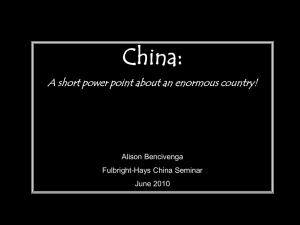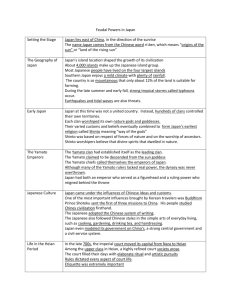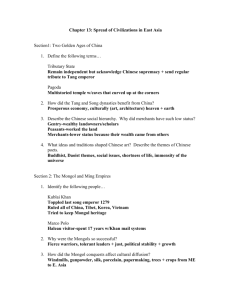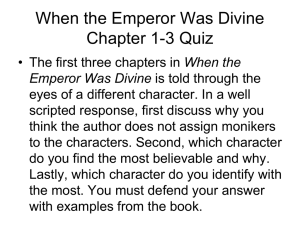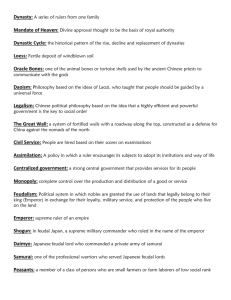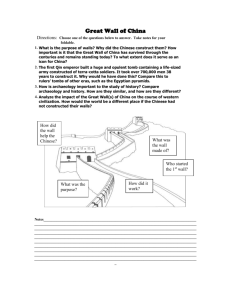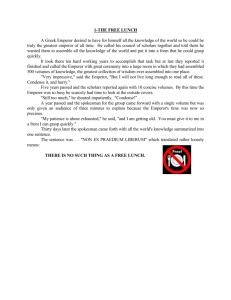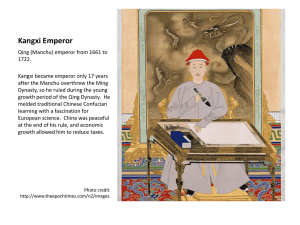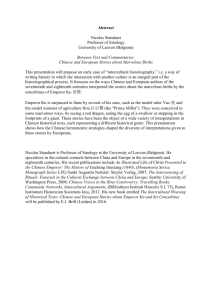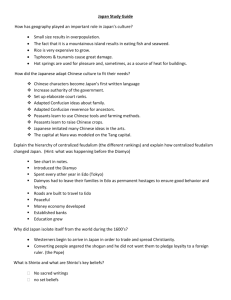Early Japanese History 400 C
advertisement
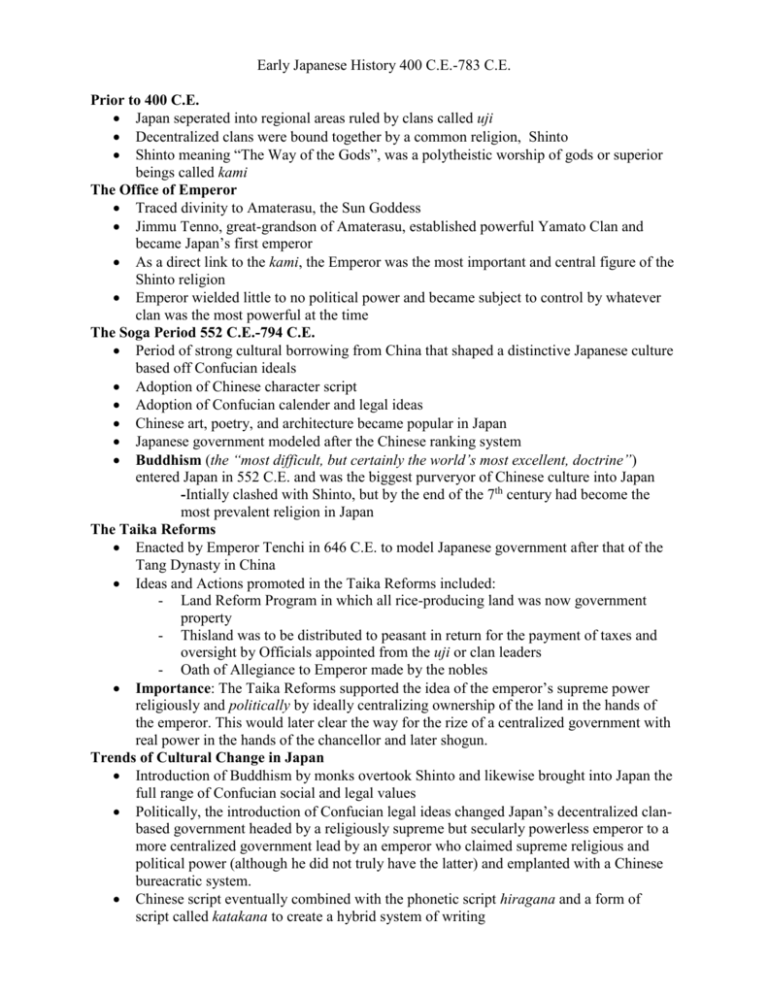
Early Japanese History 400 C.E.-783 C.E. Prior to 400 C.E. Japan seperated into regional areas ruled by clans called uji Decentralized clans were bound together by a common religion, Shinto Shinto meaning “The Way of the Gods”, was a polytheistic worship of gods or superior beings called kami The Office of Emperor Traced divinity to Amaterasu, the Sun Goddess Jimmu Tenno, great-grandson of Amaterasu, established powerful Yamato Clan and became Japan’s first emperor As a direct link to the kami, the Emperor was the most important and central figure of the Shinto religion Emperor wielded little to no political power and became subject to control by whatever clan was the most powerful at the time The Soga Period 552 C.E.-794 C.E. Period of strong cultural borrowing from China that shaped a distinctive Japanese culture based off Confucian ideals Adoption of Chinese character script Adoption of Confucian calender and legal ideas Chinese art, poetry, and architecture became popular in Japan Japanese government modeled after the Chinese ranking system Buddhism (the “most difficult, but certainly the world’s most excellent, doctrine”) entered Japan in 552 C.E. and was the biggest purveryor of Chinese culture into Japan -Intially clashed with Shinto, but by the end of the 7th century had become the most prevalent religion in Japan The Taika Reforms Enacted by Emperor Tenchi in 646 C.E. to model Japanese government after that of the Tang Dynasty in China Ideas and Actions promoted in the Taika Reforms included: - Land Reform Program in which all rice-producing land was now government property - Thisland was to be distributed to peasant in return for the payment of taxes and oversight by Officials appointed from the uji or clan leaders - Oath of Allegiance to Emperor made by the nobles Importance: The Taika Reforms supported the idea of the emperor’s supreme power religiously and politically by ideally centralizing ownership of the land in the hands of the emperor. This would later clear the way for the rize of a centralized government with real power in the hands of the chancellor and later shogun. Trends of Cultural Change in Japan Introduction of Buddhism by monks overtook Shinto and likewise brought into Japan the full range of Confucian social and legal values Politically, the introduction of Confucian legal ideas changed Japan’s decentralized clanbased government headed by a religiously supreme but secularly powerless emperor to a more centralized government lead by an emperor who claimed supreme religious and political power (although he did not truly have the latter) and emplanted with a Chinese bureacratic system. Chinese script eventually combined with the phonetic script hiragana and a form of script called katakana to create a hybrid system of writing Socially, the Japanese received and adopted much of the Chinese culture that came in a package across the East China Sea along with Confucianism and Buddhism. Idea of a fixed capital, choose Nara which was modelled after Xi’an. 200,000 in population. Came under the influence of the Buddhist monasteries and in 794 the emperor moved the capital to Heian-kyo, “Peace and Tranquility” which was 30 miles from the monasteries Hein Period 794-1185 Fugiwara Family After move to Heian, a Fugiwara was elevated to post of regent, first time a non-royal held the position. Then in 884 a Fugiwara became the chancellor, kampaku. Both of these posts became hereditary positions. The family used their posts to control the emporer and dominate political and economic life. Fuji advised the emperor to give tax-free estates shoen as gifts or rewards. Eventually the emperor no longer controlled the land and most of the estates had gone to the Fugiwara family. The emperors lost their political legitimacy due to the control of the Fugiwara family. By the end of the period, the daimyo in the countryside started fighting to battle rivals and increase land holdings. They were much more rugged than the noble who lived at the isolated court. These fueds led to the fall of the Fugiwara family and the rise of the Shogunate The Heian period is known as a time of pursuance of asthetic beauty based on Chinese ideals. Those at court were obsessed with appearance (beauty and manners). White faces for all. Women-small red lips, cheek rouge, long hair to the floor, high painted eyebrows. Men-pointy beards on tips of chins. Laughing with mouth closed, elaborate letter folding, men make their own perfumes, rules for clothing and color combinations, memorize Chinese poetry, playing Go, landscape painting, Shinto ceremonies given by the emperor. Tale of Genji 1014 CE, Murasaki Shikibu. Pillow Book, Sei Shonagon – a diary where she noted things at the emperor’s court. Feudalism and the Mongol Invasion 1185-1333 Taira and Minamoto will fight to replace the Fugiwara as counciller. 1159. Taira are briefly in power. They lost to Minamoto Yoritomo in 1185 in a sea battle. He establised a new secular government in a small seaside village, Kamakura, in eastern Japan. This marked the beginning of new era where a warrior class, samurai, ruled and not the court nobles. Samurai – code based on honor, sword was a sacred object, often given names, slept with them and often buried with them Kamakura shogunate is a bakufu, tent government. Emperor granted title: Seitaishogun meaning “Barbarian-Subduing Generalissimo” chief military ruler in Japan Japan is organized along feudal lines. Land given to lmost trusted officials in exchange for a certain number of armed samurai for service (number given based on size of land parcel) The lower samurai were then given smaller manors to maintain. Of every 12 acres given, 2 had tax-free status. Other ten subject to taxes. The Peasants lived off whatever may be left. The emperor was now only really chief Shinto priest. The Shogun ruled in all secular matters. Mongols invaded in 1274. Kublain sent 450 Mongol ships carrying 15,000 troops. Landed in Hadata Bay, Kyushu Island. Local samurai chieftains fought for two days against overwhelming odds. The second night, the Mongols went back to their ships to ready for victory the next day. A typhoon blew up and devasted the invasion force. 13,000 men were lost. The Shogun ordered a massive mobilization for the next time. Western shores built new defenses, expanded army put on 24-hour alert. Every manor had to supply a list of men and resources to be used by the gov’t in case of attack. Religious services carried out continuously. Second invasion in 1281. A force of 150,000 and Korean and Chinese allies landed in the same bay. The new Japanese navy, light and swift ships, outmaneuvered the Chinese troop transports, clunkers. 50 days of bloody fighting – then another typhoon blows up and the Mongol forces were lost again 80%. Typhoons named kamakaze, divine winds. A sense of national unity developed and they felt that victory a signal of the superiority of their way of life. Kamakura Bakufu unable to hold Japan together due to the large debt incurred by the invasion. Many preparations were paid out of the pockets of samurai – indebted to merchants. Gov’t treasury empty. Peasants had to relinquish more of crops to samaurai. Everyone is strapped for cash.
